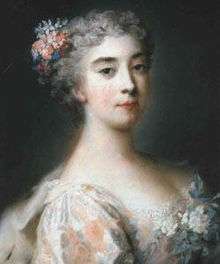Enrichetta d'Este
Princess Enrichetta d'Este (Enrichetta Maria; 27 February 1702 – 30 January 1777) was a Duchess of Parma by marriage to Antonio Farnese, Duke of Parma, who was her first cousin as well as an uncle of Elisabeth Farnese, Queen of Spain.
| Enrichetta d'Este | |||||
|---|---|---|---|---|---|
 Portrait by Rosalba Carriera (Uffizi Gallery, Florence) | |||||
| Duchess of Parma | |||||
| Reign | 5 February 1728 – 20 January 1731 | ||||
| Born | 27 February 1702 Ducal Palace of Modena, Duchy of Modena | ||||
| Died | 30 January 1777 (aged 74) Fidenza, Duchy of Parma | ||||
| Burial | Convent of the Capuciner, Fidenza, Parma | ||||
| Spouse | Antonio Farnese, Duke of Parma Leopold of Hesse-Darmstadt | ||||
| |||||
| House | Este (birth) Farnese (marriage) Hesse-Darmstadt (marriage) | ||||
| Father | Rinaldo d'Este, Duke of Modena | ||||
| Mother | Charlotte of Brunswick-Lüneburg | ||||
| Religion | Roman Catholicism | ||||
Biography
Early life
Princess Enrichetta was the third daughter of Rinaldo d'Este, Duke of Modena and Princess Charlotte of Brunswick-Lüneburg. Her older brother Prince Francesco was the heir to the duchy of Modena.
In 1720 Francesco married Charlotte Aglaé d'Orléans, the daughter of Philippe d'Orléans, the Régent of France during the childhood of King Louis XV. While at the Modenese court, Charlotte Aglaé got on well with Enrichetta and her older sisters Benedetta Maria Ernesta (1697–1777) and Amalia Giuseppina (1699–1778).
In 1725, Enrichetta was among the princesses seriously considered for marriage to king Louis XV of France, when the list of the original 99 princesses had been reduced to seventeen. However, the French Prime minister, the Duke of Bourbon, regarded her to bee of too inferior rank for the position of queen, and the unstable situation in her family a cause of rejection of her candidacy, and in the end she was removed from the list. [1]
Duchess of Parma
Enrichetta was engaged to Antonio Farnese, Duke of Parma, whose mother Princess Maria d'Este was Enrichetta's aunt. They were married with magnificent ceremonies in Modena on 5 February 1728, with her brother Francesco acting as proxy for Antonio.
She travelled to Parma where she made a magnificent entry to the city on 6 July 1728, greeted at the Porta San Michele by crowds of cheerers and onlookers. Celebrations in the local area lasted as late as 1730. Antonio frequently visited the Modenese court and was close to Erichetta's brother.
The marriage had been arranged by Antonio's secretary of state, Count Anvidi, and Bori coerced an unwilling Antonio to marry Enrichetta, his friend Francesco's sister. The marriage, despite all Antonio's attempts at conception, was childless.
The regency issue
Antonio died on 20 January 1731. The previous day, he had announced that Enrichetta was pregnant; after his death, a Regency council for the potential heir was formed, consisting of Enrichetta, a bishop, the first Secretary of State and two gentlemen of the Court.
It was decided that, should the child be female, the duchy of Parma would revert to the Infante Don Carlos (then aged 12), eldest of the three sons of Elisabeth Farnese, wife of Philip V of Spain, niece of Antonio by his older half-brother Odoardo, who had been heir-apparent to the duchy but predeceased their father.
The duchess was examined by many doctors without any confirmation of pregnancy. As a result, the Second Treaty of Vienna on 22 July 1731 officially recognised the young Infante Don Charles as the Duke of Parma and Piacenza, pursuant to the Treaty of London (1718).
Since he was still a minor, his maternal grandmother Dorothea Sophie of the Palatinate, Odoardo's widow, was named regent.
As Enrichetta continued to maintain that she was pregnant, Dorothea ordered that she be examined by four midwives, who then reported that Enrichetta was in fact seven months pregnant. The news was reported around Parma then around the European courts. However, Queen Elisabeth in Spain convinced her mother to have Enrichetta examined again in September 1731; it was then reported that there was in fact no child, and the House of Farnese was extinct.
Shunned by her father's court in Modena, the dowager duchess moved into the Ducal Palace of Colorno, where she was under virtual house arrest with an escort of Swiss Guards. In December 1731, she was forced to return to the Ducal Palace in Parma in order to return the crown jewels of Parma to Dorothea, who was made head of the regency council on 29 December 1731.
She stayed in Parma, splitting her time between Piacenza, Borgo San Donnino and Cortemaggiore.
Second marriage
On 23 March 1740 in Piacenza, Enrichetta married Prince Leopold of Hesse-Darmstadt, son of Landgrave Philip of Hesse-Darmstadt and Princess Marie Therese of Croÿ. Enrichetta and Leopold had no children.
Leopold died in 1764 leaving Enrichetta a widow for the second time. Enrichetta herself died on 30 January 1777 aged seventy four. She was buried at the Convent of the Capuchins, in Fidenza (now church of San Francesco).
Ancestry
| Ancestors of Enrichetta d'Este[2] | ||||||||||||||||||||||||||||||||||||||||||||||||||||||||||||||||||||||||||||||||||||||||||||||||||||||||||||||||||||||||||||||||||||||||||||||||||||||||||||||||||||||||||||||||||||||||||||||||||||||||||||||||||||||||||||||||||||||||||||||||||||||||||||||||||||||||||||||||||||||||||||||||||||||||||||||||||||||||||||||||||||||||||||||||||||||||||||||||||||||||||||||||||||||||||||||||||||||||||||||||||||||||||||||||||||||||||||||||||||||||||||||||||||||||||||||||||||||||||||||||||||||||||||||||||||||||||||||||||||||||||||||||||||||||||||||||||||||||||||||||||||||||||||||||||||||||||||||||
|---|---|---|---|---|---|---|---|---|---|---|---|---|---|---|---|---|---|---|---|---|---|---|---|---|---|---|---|---|---|---|---|---|---|---|---|---|---|---|---|---|---|---|---|---|---|---|---|---|---|---|---|---|---|---|---|---|---|---|---|---|---|---|---|---|---|---|---|---|---|---|---|---|---|---|---|---|---|---|---|---|---|---|---|---|---|---|---|---|---|---|---|---|---|---|---|---|---|---|---|---|---|---|---|---|---|---|---|---|---|---|---|---|---|---|---|---|---|---|---|---|---|---|---|---|---|---|---|---|---|---|---|---|---|---|---|---|---|---|---|---|---|---|---|---|---|---|---|---|---|---|---|---|---|---|---|---|---|---|---|---|---|---|---|---|---|---|---|---|---|---|---|---|---|---|---|---|---|---|---|---|---|---|---|---|---|---|---|---|---|---|---|---|---|---|---|---|---|---|---|---|---|---|---|---|---|---|---|---|---|---|---|---|---|---|---|---|---|---|---|---|---|---|---|---|---|---|---|---|---|---|---|---|---|---|---|---|---|---|---|---|---|---|---|---|---|---|---|---|---|---|---|---|---|---|---|---|---|---|---|---|---|---|---|---|---|---|---|---|---|---|---|---|---|---|---|---|---|---|---|---|---|---|---|---|---|---|---|---|---|---|---|---|---|---|---|---|---|---|---|---|---|---|---|---|---|---|---|---|---|---|---|---|---|---|---|---|---|---|---|---|---|---|---|---|---|---|---|---|---|---|---|---|---|---|---|---|---|---|---|---|---|---|---|---|---|---|---|---|---|---|---|---|---|---|---|---|---|---|---|---|---|---|---|---|---|---|---|---|---|---|---|---|---|---|---|---|---|---|---|---|---|---|---|---|---|---|---|---|---|---|---|---|---|---|---|---|---|---|---|---|---|---|---|---|---|---|---|---|---|---|---|---|---|---|---|---|---|---|---|---|---|---|---|---|---|---|---|---|---|---|---|---|---|---|---|---|---|---|---|---|---|---|---|---|---|---|---|---|---|---|---|---|---|---|---|---|---|---|---|---|---|---|---|---|---|---|---|---|---|---|---|---|---|---|---|---|---|---|---|---|---|---|---|---|---|---|---|---|---|---|---|---|---|---|---|---|---|---|---|---|---|---|---|---|---|---|---|---|---|---|---|---|---|---|---|---|---|---|---|---|---|---|---|---|---|---|---|---|---|---|---|---|---|---|---|---|---|---|---|---|---|---|---|---|---|---|---|---|---|---|---|---|---|---|---|---|---|---|---|---|---|---|---|---|---|---|---|---|---|---|---|---|---|---|---|---|---|---|---|---|---|---|---|---|---|---|---|---|---|---|---|---|
| ||||||||||||||||||||||||||||||||||||||||||||||||||||||||||||||||||||||||||||||||||||||||||||||||||||||||||||||||||||||||||||||||||||||||||||||||||||||||||||||||||||||||||||||||||||||||||||||||||||||||||||||||||||||||||||||||||||||||||||||||||||||||||||||||||||||||||||||||||||||||||||||||||||||||||||||||||||||||||||||||||||||||||||||||||||||||||||||||||||||||||||||||||||||||||||||||||||||||||||||||||||||||||||||||||||||||||||||||||||||||||||||||||||||||||||||||||||||||||||||||||||||||||||||||||||||||||||||||||||||||||||||||||||||||||||||||||||||||||||||||||||||||||||||||||||||||||||||||
References
- Edmond et Jules de Goncourt: La duchesse de Châteauroux et ses soeurs, Paris, 1906
- Genealogie ascendante jusqu'au quatrieme degre inclusivement de tous les Rois et Princes de maisons souveraines de l'Europe actuellement vivans [Genealogy up to the fourth degree inclusive of all the Kings and Princes of sovereign houses of Europe currently living] (in French). Bourdeaux: Frederic Guillaume Birnstiel. 1768. p. 85.